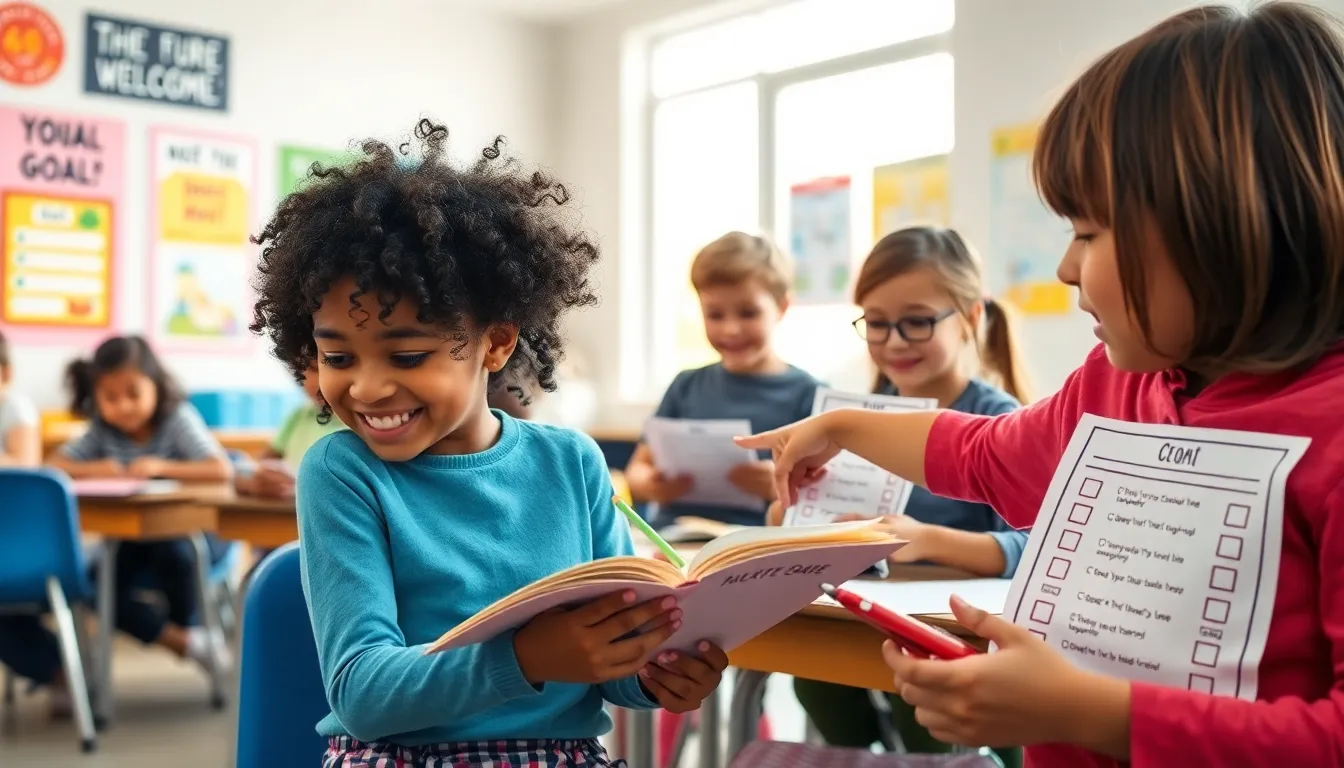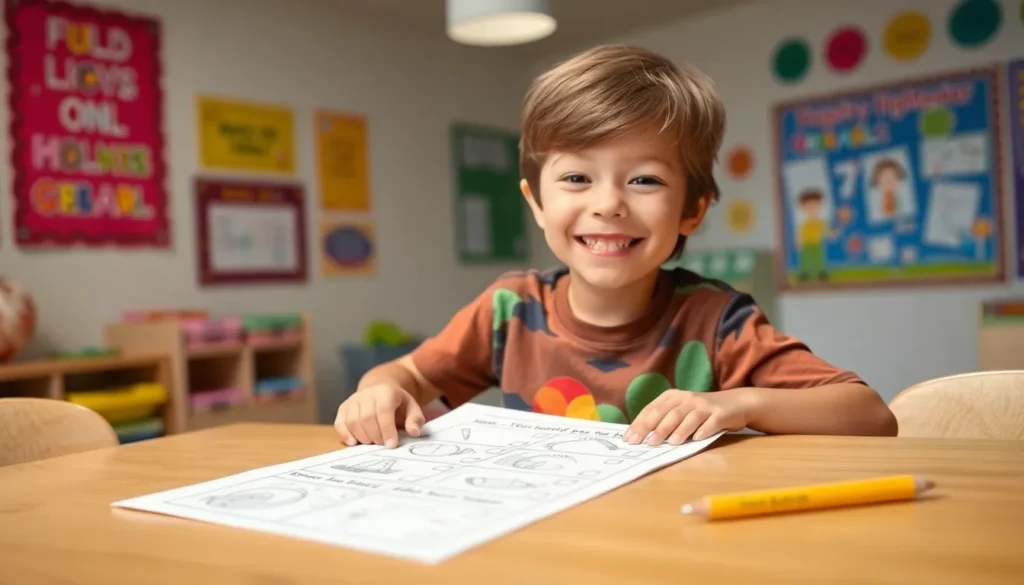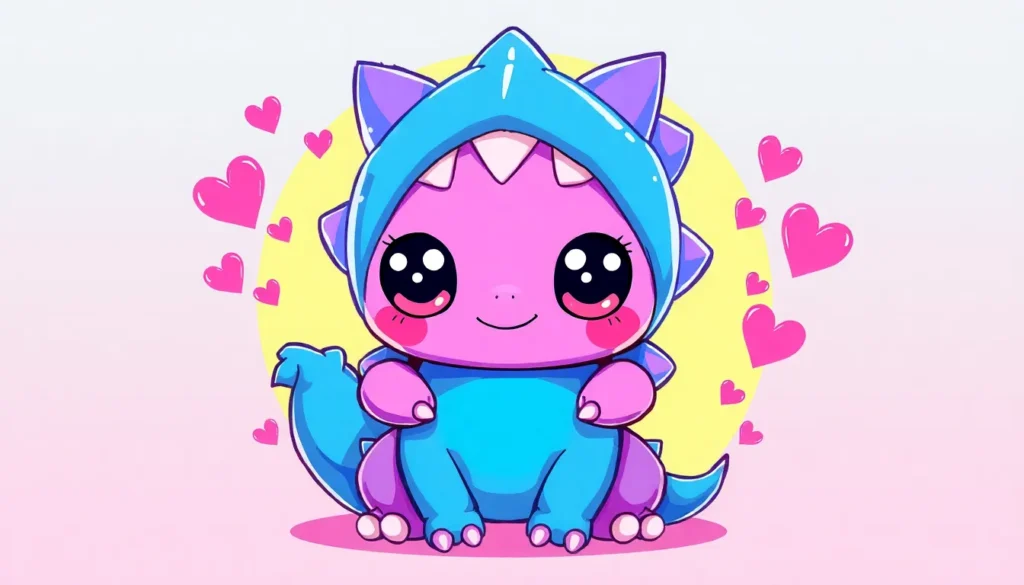Table of Contents
ToggleSetting goals isn’t just for adults in suits sipping coffee in high-rise offices. Kids can benefit from it too, and what better way to kickstart their journey than with a fun and engaging goal-setting worksheet? Imagine a world where kids not only dream big but also have the tools to make those dreams a reality. It’s like giving them a treasure map to their future!
Importance Of Goal Setting For Kids
Goal setting plays a crucial role in a child’s development. This practice fosters motivation and instills a sense of responsibility.
Benefits Of Goal Setting
Setting goals allows children to clarify their aspirations. Achieving small objectives boosts confidence, motivating them to tackle bigger challenges. It encourages persistence, teaching children to work through obstacles. Enhanced focus results when kids pursue specific targets. Improved decision-making skills emerge as they learn to evaluate choices based on their goals. Overall, goal setting cultivates a proactive mindset.
Developmental Skills Gained
Children gain essential skills through goal setting. Improved planning abilities become evident as they outline steps to reach their targets. Time management skills develop when kids prioritize their tasks effectively. Additionally, problem-solving skills enhance as they navigate challenges during their journey. Collaboration often occurs when children share goals and seek support from peers or adults. Self-discipline strengthens as they maintain their commitment, preparing them for future successes.
Components Of A Goal Setting Worksheet

A well-structured goal-setting worksheet includes several key components tailored for children. These elements enhance clarity and engagement, making the process enjoyable and effective.
Sections To Include
Worksheets should feature specific sections. Goals need clear definitions. Children benefit from understanding the difference between long-term and short-term objectives. Visual elements like checkboxes or grids can motivate kids to track their progress. Reflection areas allow children to note challenges and successes. Additional prompts can spark creativity and help them think critically about their aspirations.
Age-Appropriate Language
Using age-appropriate language is essential for engagement. Worksheets should use simple vocabulary for easy comprehension. Phrasing questions positively encourages children. For example, instead of “What do you want to improve?” consider “What new skills do you want to learn?” Incorporating relatable examples aids understanding, making the process enjoyable. Active and encouraging language builds confidence and fosters excitement about achieving goals.
How To Use A Goal Setting Worksheet For Kids
A goal-setting worksheet serves as a practical tool for children to define and achieve their aspirations. Using it effectively helps kids map their journey toward success.
Step-By-Step Guide
- Identify Goals: Begin by having children list their aspirations. Short-term and long-term goals should be included to provide a balanced perspective.
- Set Specific Objectives: Encourage specificity. Instead of vague desires, use concrete phrases like “read three books” or “improve math scores by 10%.”
- Track Progress: Incorporate checkboxes or progress bars. Visual elements keep children engaged and motivated, allowing them to see their achievements the entire way.
- Reflect on Challenges: Provide space for noting obstacles and breakthroughs. Reflecting aids children in understanding their experiences and learning from them.
- Celebrate Success: Make a point of acknowledging completed goals. Celebrations reinforce motivation and foster a positive outlook on future endeavors.
Tips For Parents And Educators
Promote the importance of setting realistic goals. Children benefit from having achievable objectives that can boost their confidence.
Encourage regular reviews of the worksheet. This practice nurtures accountability and keeps goals fresh in their minds.
Use supportive language during discussions about goals. Positive reinforcement fosters a growth mindset and encourages children to embrace challenges without fear of failure.
Offer guidance while allowing for independence. Kids should take ownership of their goals while parents and educators provide encouragement and advice as needed.
Ideas For Goals Kids Can Set
Children can benefit from setting a variety of goals that span different areas of their lives. These goals can guide them, providing direction and purpose as they grow. Below are specific categories of goals children can pursue.
Academic Goals
Academic goals focus on improving knowledge and skills within school subjects. Kids might set goals to raise their grades in math or science. Setting a target to complete all homework on time fosters responsibility. Enhancing reading skills by finishing a certain number of books each month encourages a love for literature. Another example involves mastering a specific math concept before the end of the term. With clear academic goals, children gain motivation and a sense of achievement that fuels their educational journey.
Personal Development Goals
Personal development goals help children grow emotionally and socially. They can set goals related to improving communication skills, such as practicing active listening during conversations. Developing empathy by participating in community service activities fosters compassion. Kids may also focus on managing emotions better and setting specific objectives to practice mindfulness or relaxation techniques daily. Building a personal development goal inspires children to cultivate self-awareness and resilience in everyday situations.
Extracurricular Goals
Extracurricular goals provide avenues for children to explore interests outside the classroom. Joining a sports team or art club can inspire kids to commit to consistent practice and participation. They might aim to learn a musical instrument, setting a goal to play a specific song before their next recital. Additionally, pursuing a new hobby like coding or photography invites them to broaden their horizons. Engaging in extracurricular activities helps children develop teamwork skills, creativity, and a sense of belonging within their communities.
Utilizing a goal-setting worksheet for kids can significantly impact their personal and academic growth. By guiding them through the process of defining and tracking their goals, children learn valuable skills that will serve them throughout their lives. This engaging tool not only fosters a sense of responsibility but also encourages persistence and self-discipline.
As kids celebrate their achievements and reflect on challenges, they build confidence and a proactive mindset. Empowering children to take ownership of their goals prepares them for future successes in various aspects of life. With the right support and resources, goal setting can become an exciting adventure that shapes their aspirations and dreams.




